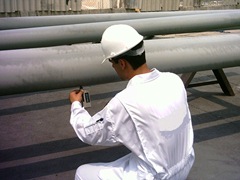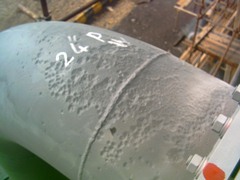
The Piping Inspection article provides you with information about the inspection of piping and piping testing in a construction site, as well as in operating plants.
Based on API Code, the definition of pipe is a pressure-tight cylinder used to convey a fluid or to transmit a fluid pressure.
The I4I Academy API 570 Piping Inspector course covers all inspection and testing requirements for piping systems placed in service. The I4I Academy API Source Inspector fixed Equipment Course covers piping inspection during construction.
If you look to the refinery or chemical plant, you can see the jungle of pipes which are connecting the vessels together. Statistic shows that 40 % of total mechanical failures in the units are because of the process piping.
This article provides you information about site inspection of process piping as well as important points on in-service inspection in process plants.
The construction code for process piping is ASME B31.3 Code and it covers the minimum requirements for design, materials, fabrication, inspection, testing, and commissioning.
With the above explanation, your inspection and test plan (ITP) for process piping needs to meet the requirements of ASME B31.3 Code.
ASME B31.3 refers you to the other ASME code sections for some activities. For example for welding refer to the ASME Code Section IX, pipe fitting design and selection to the ASME B16.5 and for Nondestructive testing to ASME Code Section V.
The process piping design and construction is not under the ASME Code scheme of stamped items.
It means there is not certification for construction contractors by ASME, and it is the responsibility of owner to select a qualified and experienced contractor for its process piping construction project.
This is the reason that in the ASME B31.3 code you cannot see the wording of “Authorized Inspector,” and instead the words “owner inspector” have been used.
The owner inspector can be the owner's own qualified inspector or the inspector of a third party inspection company under contract with the owner.
Throughout the ASME Construction codes, when you see the words “authorized inspector,” you notice there is an ASME Stamp scheme there.
Contrary to the ASME B31.3, the ASME B31.1 code for power piping (boiler external piping) have the ASME stamp scheme. The construction contractor must be certified by the ASME organization and must hold the “PP” stamp.
So the wording for inspector in the ASME B31.1 is "authorized inspector," which means that this person has specific qualifications and a commission card from NBIC.
For more details, review the Pressure Vessel Certification article. The certification process for the power piping contractor is similar to the pressure vessel.
The detail of inspection requirement in the construction field is addressed in the process piping inspection and test plan.
The In-Service Inspection code for your process piping is API STD 570.
The title of the code is Piping Inspection Code: In-service Inspection, Rating, Repair, and Alteration of Piping Systems.
The other API recommendation practices and codes are also necessary to be used in conjunction with this Code.

Some of these Recommend Practices are:
ASME construction and referenced code sections also might be used such as ASME B31.3 and ASME Code Section IX.
For repair, the requirement of API STD 570, or ASME PCC-2 need to be met.
The title of ASME-PCC-2, which was first published in 2006 is: “Repair of Pressure Equipment and Piping.”
The API 570 Piping Inspectors are qualified persons to do the piping system inspection.
The API 570 Training Course is 6 days video training program and available online and is the Prep course for API 570 Piping nspector Exam. Besides the student that successfully pass this training course exam, receive I4I academy certificate with 48 hours training credit.
These are only important points or a summary of points for the process piping in-service inspection and should not be assumed as the entire piping inspection procedure.
A piping inspection procedure is a comprehensive document, which need to cover inspection methods to be employed, equipment and material to be used, qualification of inspection personnel involved and the sequence of the inspection activities at the minimum.
You may use the following content as a summary of points for the in-service inspection of the piping system.
Sign up to receive my monthly newsletter covering all the latest courses and updates.